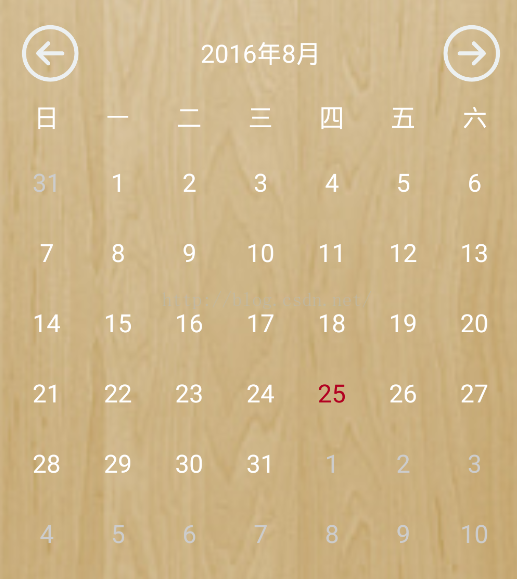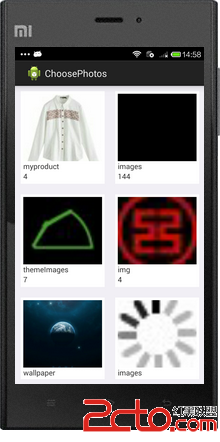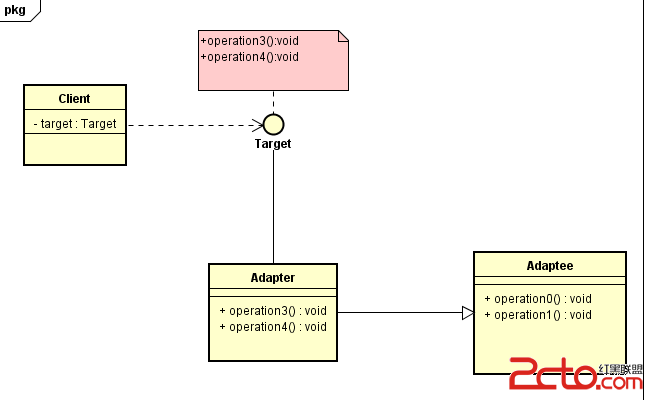編輯:關於Android編程
最近無聊在做一個項目,需要用到日歷。日歷並不需要太復雜,只需要能夠簡單的查看就行,所以我選用了java提供的Calendar類,和安卓的gridView組合的形式.
先看效果圖:

背景什麼的先不要管他。只看主體部分,左箭頭查看上個月的,右箭頭查看下個月的.
接下來開始我們的日歷。
首先,需要使用Calendar自己構造一個DateUtils類,這個相當簡單。
import java.util.Calendar;
/**
* Created by 91905 on 2016/8/22 0022.
*/
public class DateUtils {
/**
* 獲取當前年份
*
* @return
*/
public static int getYear() {
return Calendar.getInstance().get(Calendar.YEAR);
}
/**
* 獲取當前月份
*
* @return
*/
public static int getMonth() {
return Calendar.getInstance().get(Calendar.MONTH) + 1;
}
/**
* 獲取當前日期是該月的第幾天
*
* @return
*/
public static int getCurrentDayOfMonth() {
return Calendar.getInstance().get(Calendar.DAY_OF_MONTH);
}
/**
* 獲取當前日期是該周的第幾天
*
* @return
*/
public static int getCurrentDayOfWeek() {
return Calendar.getInstance().get(Calendar.DAY_OF_WEEK);
}
/**
* 獲取當前是幾點
*/
public static int getHour() {
return Calendar.getInstance().get(Calendar.HOUR_OF_DAY);//二十四小時制
}
/**
* 獲取當前是幾分
*
* @return
*/
public static int getMinute() {
return Calendar.getInstance().get(Calendar.MINUTE);
}
/**
* 獲取當前秒
*
* @return
*/
public static int getSecond() {
return Calendar.getInstance().get(Calendar.SECOND);
}
/**
* 根據傳入的年份和月份,獲取當前月份的日歷分布
*
* @param year
* @param month
* @return
*/
public static int[][] getDayOfMonthFormat(int year, int month) {
Calendar calendar = Calendar.getInstance();
calendar.set(year, month - 1, 1);//設置時間為每月的第一天
//設置日歷格式數組,6行7列
int days[][] = new int[6][7];
//設置該月的第一天是周幾
int daysOfFirstWeek = calendar.get(Calendar.DAY_OF_WEEK);
//設置本月有多少天
int daysOfMonth = getDaysOfMonth(year, month);
//設置上個月有多少天
int daysOfLastMonth = getLastDaysOfMonth(year, month);
int dayNum = 1;
int nextDayNum = 1;
//將日期格式填充數組
for (int i = 0; i < days.length; i++) {
for (int j = 0; j < days[i].length; j++) {
if (i == 0 && j < daysOfFirstWeek - 1) {
days[i][j] = daysOfLastMonth - daysOfFirstWeek + 2 + j;
} else if (dayNum <= daysOfMonth) {
days[i][j] = dayNum++;
} else {
days[i][j] = nextDayNum++;
}
}
}
return days;
}
/**
* 根據傳入的年份和月份,判斷上一個有多少天
*
* @param year
* @param month
* @return
*/
public static int getLastDaysOfMonth(int year, int month) {
int lastDaysOfMonth = 0;
if (month == 1) {
lastDaysOfMonth = getDaysOfMonth(year - 1, 12);
} else {
lastDaysOfMonth = getDaysOfMonth(year, month - 1);
}
return lastDaysOfMonth;
}
/**
* 根據傳入的年份和月份,判斷當前月有多少天
*
* @param year
* @param month
* @return
*/
public static int getDaysOfMonth(int year, int month) {
switch (month) {
case 1:
case 3:
case 5:
case 7:
case 8:
case 10:
case 12:
return 31;
case 2:
if (isLeap(year)) {
return 29;
} else {
return 28;
}
case 4:
case 6:
case 9:
case 11:
return 30;
}
return -1;
}
/**
* 判斷是否為閏年
*
* @param year
* @return
*/
public static boolean isLeap(int year) {
if ((year % 4 == 0 && year % 100 != 0) || year % 400 == 0) {
return true;
}
return false;
}
}
其中DateUtils類中的
public static int[][] getDayOfMonthFormat(int year, int month) {
Calendar calendar = Calendar.getInstance();
calendar.set(year, month - 1, 1);//設置時間為每月的第一天
//設置日歷格式數組,6行7列
int days[][] = new int[6][7];
//設置該月的第一天是周幾
int daysOfFirstWeek = calendar.get(Calendar.DAY_OF_WEEK);
//設置本月有多少天
int daysOfMonth = getDaysOfMonth(year, month);
//設置上個月有多少天
int daysOfLastMonth = getLastDaysOfMonth(year, month);
int dayNum = 1;
int nextDayNum = 1;
//將日期格式填充數組
for (int i = 0; i < days.length; i++) {
for (int j = 0; j < days[i].length; j++) {
if (i == 0 && j < daysOfFirstWeek - 1) {
days[i][j] = daysOfLastMonth - daysOfFirstWeek + 2 + j;
} else if (dayNum <= daysOfMonth) {
days[i][j] = dayNum++;
} else {
days[i][j] = nextDayNum++;
}
}
}
return days;
}
是將當前月份的日期分布保存到數組中返回.
接下來,布局文件
GridView的item文件
GridView的Adapter文件
import android.content.Context;
import android.graphics.Color;
import android.view.LayoutInflater;
import android.view.View;
import android.view.ViewGroup;
import android.widget.BaseAdapter;
import android.widget.TextView;
import com.jiaoml.smallmusic.MusicApp;
import com.jiaoml.smallmusic.R;
import com.jiaoml.smallmusic.music.Record;
import com.lidroid.xutils.db.sqlite.Selector;
import com.lidroid.xutils.db.sqlite.WhereBuilder;
import com.lidroid.xutils.exception.DbException;
/**
* Created by 91905 on 2016/8/24 0024.
*/
public class DateAdapter extends BaseAdapter {
private int[] days = new int[42];
private Context context;
private int year;
private int month;
public DateAdapter(Context context, int[][] days, int year, int month) {
this.context = context;
int dayNum = 0;
//將二維數組轉化為一維數組,方便使用
for (int i = 0; i < days.length; i++) {
for (int j = 0; j < days[i].length; j++) {
this.days[dayNum] = days[i][j];
dayNum++;
}
}
this.year = year;
this.month = month;
}
@Override
public int getCount() {
return days.length;
}
@Override
public Object getItem(int i) {
return days[i];
}
@Override
public long getItemId(int i) {
return i;
}
@Override
public View getView(int i, View view, ViewGroup viewGroup) {
ViewHolder viewHolder;
if (view == null) {
view = LayoutInflater.from(context).inflate(R.layout.date_item, null);
viewHolder = new ViewHolder();
viewHolder.date_item = (TextView) view.findViewById(R.id.date_item);
view.setTag(viewHolder);
} else {
viewHolder = (ViewHolder) view.getTag();
}
if (i < 7 && days[i] > 20) {
viewHolder.date_item.setTextColor(Color.rgb(204, 204, 204));//將上個月的和下個月的設置為灰色
} else if (i > 20 && days[i] < 15) {
viewHolder.date_item.setTextColor(Color.rgb(204, 204, 204));
}
viewHolder.date_item.setText(days[i] + "");
return view;
}
/**
* 優化Adapter
*/
class ViewHolder {
TextView date_item;
}
接下來是Activity文件
import android.app.Activity;
import android.os.Bundle;
import android.view.View;
import android.widget.GridView;
import android.widget.ImageView;
import android.widget.TextView;
import com.jiaoml.smallmusic.R;
import com.jiaoml.smallmusic.adapter.DateAdapter;
/**
* Created by 91905 on 2016/8/24 0024.
*/
public class MainActivity extends Activity implements View.OnClickListener {
private GridView record_gridView;//定義gridView
private DateAdapter dateAdapter;//定義adapter
private ImageView record_left;//左箭頭
private ImageView record_right;//右箭頭
private TextView record_title;//標題
private int year;
private int month;
private String title;
private int[][] days = new int[6][7];
@Override
protected void onCreate(Bundle savedInstanceState) {
super.onCreate(savedInstanceState);
//初始化日期數據
initData();
//初始化組件
initView();
//組件點擊監聽事件
initEvent();
}
private void initData() {
year = DateUtils.getYear();
month = DateUtils.getMonth();
}
private void initEvent() {
record_left.setOnClickListener(this);
record_right.setOnClickListener(this);
}
private void initView() {
/**
* 以下是初始化GridView
*/
record_gridView = (GridView) findViewById(R.id.record_gridView);
days = DateUtils.getDayOfMonthFormat(2016, 8);
dateAdapter = new DateAdapter(this, days, year, month);//傳入當前月的年
record_gridView.setAdapter(dateAdapter);
record_gridView.setVerticalSpacing(60);
record_gridView.setEnabled(false);
/**
* 以下是初始化其他組件
*/
record_left = (ImageView) findViewById(R.id.record_left);
record_right = (ImageView) findViewById(R.id.record_right);
record_title = (TextView) findViewById(R.id.record_title);
}
/**
* 下一個月
*
* @return
*/
private int[][] nextMonth() {
if (month == 12) {
month = 1;
year++;
} else {
month++;
}
days = DateUtils.getDayOfMonthFormat(year, month);
return days;
}
/**
* 上一個月
*
* @return
*/
private int[][] prevMonth() {
if (month == 1) {
month = 12;
year--;
} else {
month--;
}
days = DateUtils.getDayOfMonthFormat(year, month);
return days;
}
/**
* 設置標題
*/
private void setTile() {
title = year + "年" + month + "月";
record_title.setText(title);
}
@Override
public void onClick(View view) {
switch (view.getId()) {
case R.id.record_left:
days = prevMonth();
dateAdapter = new DateAdapter(this, days, year, month);
record_gridView.setAdapter(dateAdapter);
dateAdapter.notifyDataSetChanged();
setTile();
break;
case R.id.record_right:
days = nextMonth();
dateAdapter = new DateAdapter(this, days, year, month);
record_gridView.setAdapter(dateAdapter);
dateAdapter.notifyDataSetChanged();
setTile();
break;
}
}
}
 Android用GridView排列相冊,實現微信選擇圖片效果
Android用GridView排列相冊,實現微信選擇圖片效果
許多項目都必須用到上傳圖片的功能,有了圖片會更加精彩,最近我的項目也需要選擇圖片的功能,所以把我寫的代碼共享出來,也算是筆記吧!好,廢話少說,下面看看效果圖: 效果還
 Android安卓破解之逆向分析SO常用的IDA分析技巧
Android安卓破解之逆向分析SO常用的IDA分析技巧
1、結構體的創建及導入,結構體指針等。以JniNativeInterface, DexHeader為例。解析Dex的函數如下: F5後如下:&nbs
 最新基於高德地圖的android進階開發(3)GPS地圖定位
最新基於高德地圖的android進階開發(3)GPS地圖定位
1.下面示例是一個簡單的定位,來自官網,對這些源碼加了一些注釋,這樣看起來可能會更容易理解一點。2.直接上源碼androidManifest.xml
 Android框架設計模式(四)——Adapter Method
Android框架設計模式(四)——Adapter Method
一、適配器模式介紹適配器在平常在生活中是經常會用到的,特別是電子產品。像手機、電腦、家用電器都會用到適配器來轉換電壓的大小,以提供合適的電壓。適配器就是把原來不符合要求的